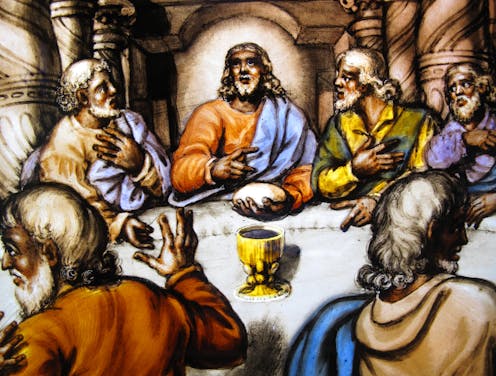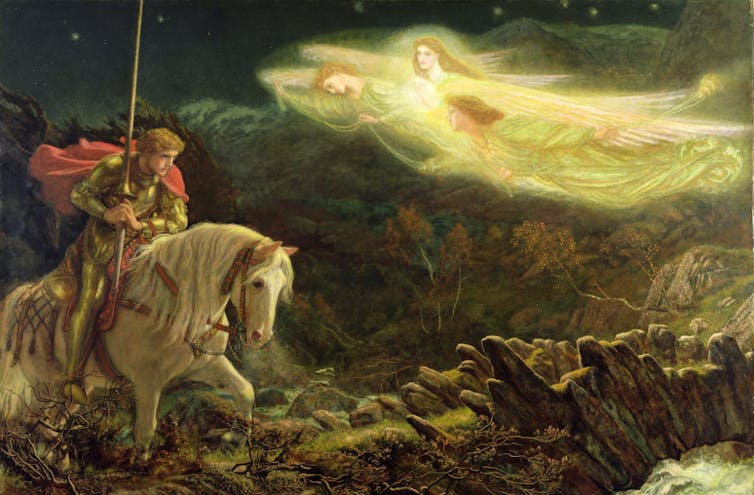Why is an ultimate goal called a ‘Holy Grail?’
- Written by Joanne M. Pierce, Professor Emerita of Religious Studies, College of the Holy Cross
 An 18th-century stained glass window panel by William Peckitt, showing The Last Supper of Christ and the disciples.TonyBaggett via iStock / Getty Images Plus
An 18th-century stained glass window panel by William Peckitt, showing The Last Supper of Christ and the disciples.TonyBaggett via iStock / Getty Images PlusFor decades, winning an Olympic medal has been described as the Holy Grail of sports.
Athletes aren’t the only ones in search of a Holy Grail. For example, in 2012, when physicists discovered the Higgs boson, a particle viewed as one of the fundamental building blocks of the universe, it was described as “a true Holy Grail.” In the same way, many automobile enthusiasts list several collectible cars as Holy Grails because they are so rare that it is a real challenge to find them.
 Quincy Hall, left, of the United States, who won the men’s 400-meter final at the 2024 Summer Olympics, on Aug. 7, 2024, in Saint-Denis, France.AP Photo/Martin Meissner
Quincy Hall, left, of the United States, who won the men’s 400-meter final at the 2024 Summer Olympics, on Aug. 7, 2024, in Saint-Denis, France.AP Photo/Martin MeissnerIn general, people refer to a goal that seems almost impossible to reach as a Holy Grail. More technically, the term Holy Grail refers specifically to the cup that Jesus used at the Last Supper. But exactly what is the quest for the Holy Grail?
As a specialist in medieval Christian history, I know that several important threads have combined over the centuries to give rise to the Holy Grail metaphor commonly used nowadays. These include elements of pre-Christian mythology, the veneration of relics in Christian tradition, and medieval literature from Britain and France.
King Arthur and the Round Table
The first complete legend of the Holy Grail as we know it today comes from 15th-century Britain. In “Le Morte d’Arthur,” Thomas Malory described in detail the virtues of the mythic hero King Arthur and deeds of the Knights of the Round Table, such as Sir Lancelot and Sir Gawain.
In some of the adventures, a maiden carrying the Holy Grail, called the Sangreal, mysteriously appears in certain castles. It provides food for the healthy and heals the wounded who drink from it. But in King Arthur’s court, the Holy Grail disappears after a miraculous feast, and all of the knights swear to go on a quest for it.
An earlier prophesy foretold that one young knight, Sir Galahad, would be the one to find the Grail. Believed to be a descendant of Joseph of Arimathea, a biblical figure who buried Jesus after his crucifixion, he was considered pure enough to find the Holy Grail. In the end, Galahad does find it, but his success doesn’t last long; his soul is taken to heaven along with the Grail.
Malory’s legend was fueled by a rekindled European interest in the Holy Land and the historical events of Jesus’ life during the time of the Crusades in the late 11th to late 13th centuries. In composing it, he drew together several elements from pre-Christian Celtic mythology and Christian devotional practice.
Two themes that Malory weaves into the Holy Grail legend are the heroic quest and the magical healing dish or cup.
Celtic mythology contains stories about heroes making arduous journeys in search of a goal, what we would call a quest. A legend from early Irish mythology, “The Quest of the Sons of Turenn,” tells the story of an epic journey of three brothers who kill a warrior leader, Ciran, who is an enemy of their father, Turenn. Later, they admit their guilt to Ciran’s son, the divine warrior Lugh. Lugh asks for compensation for his father’s murder, and demands they go on a dangerous quest to find several symbolic objects as repayment.
Irish and Welsh mythology also referred to certain magical, life-giving objects, such as deep dishes or cups that could heal the wounded with food or drink, as the Holy Grail does in Malory’s King Arthur legend.
The Grail as a Christian relic
After Christianity spread from the Holy Land to ancient Gaul – modern-day France was a part of this area – and Roman Britain by the fourth century, elements of pre-Christian legends began to mix into Christian literature.
Visitors to the Holy Land during these early medieval centuries brought back many objects for veneration, called relics – especially those supposed to be associated with the life of Jesus. Even today, several European churches claim to have Jesus’ crib, the actual nails used at his crucifixion or parts of the crown of thorns placed on his head.
But there was no mention of the Grail, supposedly the cup he used at the Last Supper, as a relic of Jesus’ life in these early centuries. The first accounts of King Arthur from the ninth and 12th histories of Britain also do not mention the Holy Grail.
The early Grail story
 A painting showing Sir Galahad in the quest for the Holy Grail.Arthur Hughes via Wikimedia Commons
A painting showing Sir Galahad in the quest for the Holy Grail.Arthur Hughes via Wikimedia CommonsThe first mention of a quest for a Holy Grail is found in a late 12th century French poem by Chretien du Troyes, called “Perceval, Le conte du Graal” – the story of the Grail. Here, a young knight, Perceval, encounters a strange procession while he is dining as a guest in a foreign castle. A young woman appears bearing what is described as a shining, golden grail decorated with gems. The original word used could refer to a kind of deep platter as well as a cup.
This vessel is not specifically identified with the cup of the Last Supper, but it is the first mention in Christian literature of a special vessel called a grail, or graal.
Subsequently, the Holy Grail figures in an early 13th-century poem by Robert de Boron, now specifically connecting the Grail with a disciple of Jesus, Joseph of the Jewish city of Arimathea. In all four Gospels, he asks for Jesus’ body to bury it in a tomb. His request was granted, probably because he was either a rich man or a member of the Jewish ruling council, the Sanhedrin.
By this time, other legends were also circulating. Joseph was said to be a relative of Jesus and to have been given custody of the Holy Grail after the resurrection. Since he had traveled to Britain as a tin merchant, the apostles asked him to bring the Holy Grail in secret to Glastonbury to hide it.
When Malory composed his version of the legend of King Arthur in the 15th century, he assembled all of these earlier elements: the holy cup, or Grail, that Jesus used at the Last Supper, its presence as a sacred relic in Britain, King Arthur and his knights envisioning a quest to find it, and its discovery by a pure hero, himself a descendant of Joseph of Arimathea.
A real Holy Grail?
 The Holy Grail depicted on a stained-glass window at Quimper Cathedral in France.Thesupermat via Wikimedia Commons, CC BY-NC-SA
The Holy Grail depicted on a stained-glass window at Quimper Cathedral in France.Thesupermat via Wikimedia Commons, CC BY-NC-SAVeneration of relics is still an important part of Catholic devotion. Today, two churches in Spain claim to have the real Holy Grail: Valencia and, since 2014, Leon. Others trace the idea back to early medieval church paintings in Spain, of Mary holding a bright cup. But still others stress that the Grail is “a literary object.”
The influence that the legend of the Holy Grail has had on contemporary culture, especially in novels and movies, is perhaps more important than its origins. In some Hollywood movies such as “Raiders of the Lost Ark” and “The Da Vinci Code,” the Holy Grail is the actual object sought. In others, the quest is altered, focusing on finding other powerful objects, or destroying a dangerous objector objects, since they have the potential to bring about great evil rather than great good. The quest for the Holy Grail has even been spoofed in the comedy “Monty Python and the Holy Grail.”
Today, the Holy Grail is still a powerful metaphor for a greatly desired, ultimate achievement, which is beyond the reach of all but a resolute and deserving few. Some Olympic athletes do, after all, win those medals, some physicists do find theoretical subatomic particles, and rare automobile collectors do find that one-of-a-kind car.
Joanne M. Pierce does not work for, consult, own shares in or receive funding from any company or organization that would benefit from this article, and has disclosed no relevant affiliations beyond their academic appointment.
Authors: Joanne M. Pierce, Professor Emerita of Religious Studies, College of the Holy Cross
Read more https://theconversation.com/why-is-an-ultimate-goal-called-a-holy-grail-235873
